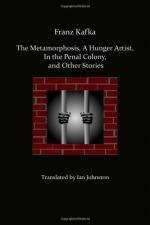|
This section contains 295 words (approx. 1 page at 400 words per page) |

|
A Hunger Artist Summary & Study Guide Description
A Hunger Artist Summary & Study Guide includes comprehensive information and analysis to help you understand the book. This study guide contains the following sections:
This detailed literature summary also contains Bibliography and a Free Quiz on A Hunger Artist by Franz Kafka.
Franz Kafka's "A Hunger Artist" was first written in 1922 and published in a collection also entitled A Hunger Artist. Although Kafka died in 1924, as he was still in the process of correcting the galley proofs, the collection was nevertheless published that same year. "A Hunger Artist" is one of the few manuscripts which Kafka did not request that his friends burn or otherwise destroy after his death.
"A Hunger Artist," which takes place in an unspecified time and place, is about a man worldfamous for his public performances of the act of fasting, for as much as forty days at a time. Even at the height of his career, the hunger artist is unsatisfied with his work and frustrated by both his manager and his audiences, who never fully appreciate his true talent or the purity of his "art." The hunger artist struggles internally with his sense of dissatisfaction with himself and his feelings of alienation from the world outside the "cage" in which he fasts. As the years go by, the hunger artist's profession goes out of vogue, while audiences move on to newer trends in mass entertainment.
Kafka's stories are often described as fables or parables, and "A Hunger Artist" certainly shares this quality. It is just absurd enough to suggest that its meaning is symbolic rather than literal. As in many of Kafka's stories, "A Hunger Artist" also explores themes of self-hatred, inadequacy, and alienation. "Hunger" becomes symbolic of both a lust for life and a spiritual yearning. The circumstance of the protagonist confined in a claustrophobic space is also a common motif in Kafka's work. The hunger artist's "cage" functions as both a refuge from the outside world and a barrier between the artist and the rest of humanity.
Read more from the Study Guide
|
This section contains 295 words (approx. 1 page at 400 words per page) |

|



